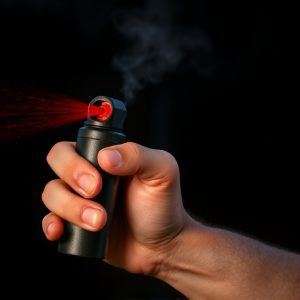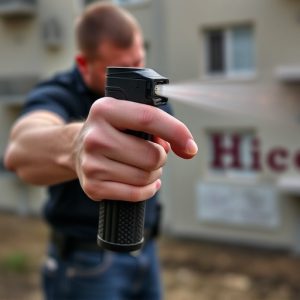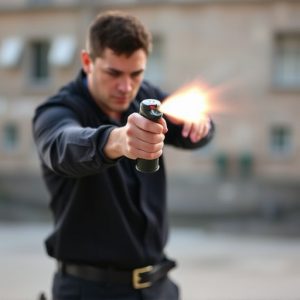Understanding and Evaluating Strongest Legal Pepper Spray Concentration for Law Enforcement
The effectiveness of pepper spray relies on its active ingredient, capsaicin, with the strongest leg…….
The effectiveness of pepper spray relies on its active ingredient, capsaicin, with the strongest legal pepper spray concentration (2% – 5% w/v) offering optimal balance between neutralizing threats and adhering to global regulations. Law enforcement agencies must follow strict guidelines regarding usage, focusing on officer safety, minimizing harm to bystanders, and maintaining public order, with non-compliance leading to legal repercussions. Well-trained personnel are crucial for responsible deployment within these legal boundaries.
“In the realm of law enforcement, pepper spray stands as a versatile tool for crowd control and self-defense. This article delves into the intricacies of this powerful weapon, focusing on its composition, effectiveness, and legal considerations. We explore the science behind pepper spray, examining how its unique formula disrupts vision and breathing. Furthermore, we analyze the regulatory landscape governing its use by law enforcement officials, with a particular emphasis on understanding the strongest legal pepper spray concentration allowed.”
- Understanding Pepper Spray: Its Composition and Effectiveness
- Legal Considerations: Regulation and Use of Pepper Spray by Law Enforcement
- Evaluating the Strength: What Concentration Matters in Legal Pepper Spray Weapons
Understanding Pepper Spray: Its Composition and Effectiveness
Pepper spray, a powerful non-lethal weapon, is designed to incapacitate individuals temporarily through irritant chemicals. Its primary active ingredient is capsaicin, the same compound that gives chili peppers their heat. The concentration of this chemical determines the spray’s effectiveness, with the strongest legal pepper spray concentration offering the most potent defense. Typically measured in percent, this concentration ensures a fast acting and reliable response during law enforcement operations.
The effectiveness of pepper spray lies not only in its composition but also in its delivery system. A well-designed spray gun allows for accurate application, ensuring the chemical comes into direct contact with the target’s eyes and respiratory system. This combination of high capsaicin concentration and precise application makes pepper spray a valuable tool for law enforcement, providing an efficient means to control and subdue individuals without causing permanent harm.
Legal Considerations: Regulation and Use of Pepper Spray by Law Enforcement
In many jurisdictions, law enforcement agencies are required to adhere to strict regulations when it comes to the use and carrying of pepper spray as a less-lethal weapon. The focus is not only on ensuring officer safety but also on minimizing harm to bystanders and maintaining public order. One of the key considerations is the strength or concentration of the pepper spray, with many regions setting legal limits on the active ingredient’s concentration. The strongest legal pepper spray concentration varies across countries and states, typically ranging from 0.2% to 1.35% capsaicin, the active ingredient responsible for the burning sensation.
These regulations often dictate specific procedures for the use of pepper spray, including when it is deemed appropriate, how officers should apply it, and the de-escalation strategies that must be employed before resorting to such force. Non-compliance with these rules can lead to legal repercussions for both the agency and individual officers. As a result, law enforcement agencies must ensure their personnel are well-trained in the proper use of pepper spray while respecting the legal boundaries surrounding its concentration and deployment.
Evaluating the Strength: What Concentration Matters in Legal Pepper Spray Weapons
When evaluating legal pepper spray weapons, understanding the concentration of capsaicin, the active ingredient, is paramount. The strongest legal pepper spray concentration typically ranges from 2% to 5% w/v (weight per volume). This concentration ensures effectiveness in neutralizing an aggressor while adhering to legal restrictions.
Below 2%, the spray might not provide enough punch to incapacitate an individual effectively, rendering it less useful for law enforcement purposes. Concentrations exceeding 5% can be excessive and potentially harmful to bystanders, which is why many jurisdictions set upper limits. Thus, striking the right balance within this range is crucial for ensuring both safety and efficacy in law enforcement operations.
In light of the above discussions, it’s clear that the strongest legal pepper spray concentration—as determined by its capsaicin content—is a critical factor in ensuring its effectiveness as a law enforcement tool. While regulatory frameworks vary across jurisdictions, adhering to industry standards and selecting weapons with precise concentrations can significantly enhance officer safety and minimize unintended harm to civilians. Understanding both the science behind pepper spray and the legal parameters governing its use is paramount for law enforcement agencies aiming to equip their officers with the most efficient and responsible tools possible.


